 United Kingdom (1901)
United Kingdom (1901)Drake, Good Hope, King Alfred, Leviathan.
WW1 RN Cruisers
Blake class | Edgar class | Powerful class | Diadem class | Cressy class | Drake class | Monmouth class | Devonshire class | Duke of Edinburgh class | Warrior class | Minotaur classIris class | Leander class | Mersey class | Marathon class | Apollo class | Astraea class | Eclipse class | Arrogant class | Highflyer class
Pearl class | Pelorus class | Gem class | Forward class | Boadicea class | Blonde class | Active class | Bristol class | Weymouth class | Chatham class | Birmingham class | Birkenhead class | Arethusa class | Caroline class | Calliope class | Cambrian class | Centaur class | Caledon class | Ceres class | Carlisle class | Danae class | Cavendish class | Emerald class
A new class of large armoured cruisers
The 1897 Powerful class marked its era as the most impressive cruisers in the Western Hemisphere, but they has been considered since as one of a kind “white elephants”, leading to the construction of more reasonable series of the Diadem (1898) and Cressy (1900) classes, the first eight being the last massive protected cruisers, while the new ones were the first true “armoured cruisers”; They were to be designed by Sir William White, Chief Constructor of the Royal Navy, in response to the new French armoured cruiser Jeanne d’Arc. There was also the threat of new armoured cruisers being built in Russia, Italy or Japan that triggered plans for a larger class of ships anyway, leading to the Drake class. Two were sunk in action, two survived the war.
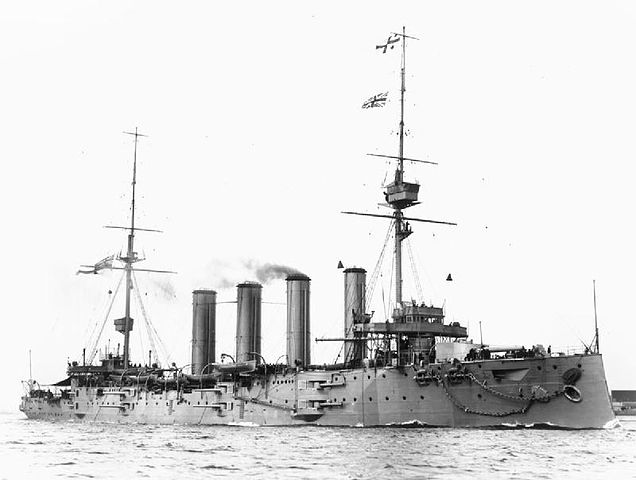
HMS Good Hope, the only one sunk in battle.
Development
The Drake was provided under the 1898/99 programme, as armoured equivalent of the earlier Powerful class. Compared to the previous Cressy they were about 3000 tons more, most of the extra space being dedicated to boilers for an increase of 2 knots, at 23 knots. This extra space also helped stacking four more 6 in guns and improvements in protection. They has been started respectively at Pembroke (April 1899), Fairfield (Sept. 1899), Vickers (Aug. 1899) and J Brown Clydebank (Nov. 1899), launched in 1901 and accepted into service in 1902 (Good Hope) and 1903. On trials they all exceeded their expected top speed (24 knots for Drake), even achieving hours long cruises at full speed without incident. They were considered good steamers, excellent seaboats. Their large size meant their operational career was spent as cruiser squadron leaders.
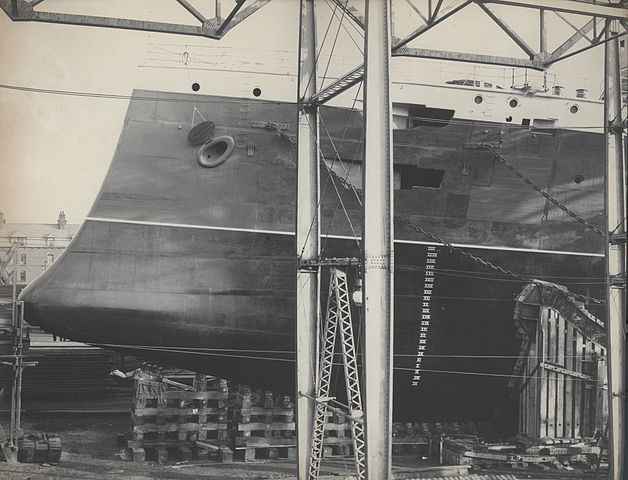
King Alfred in construction – the ram bow
Design
By size, these ships were much larger than the previous Cressy, in lenght particularly with 152 m instead of 134 m, and were wider also at 21,74 instead of 21,18 m, but the same draught. Their impressive machinery comprised 43 Belleville boilers, feeding four Triple expansion 4-cycle engines producing a total of 30,000 ihp for 23 knots. They carried 2500 tons of coal versus 1600 on previous ships, making them suited for far overseas stations.
Armour scheme was of a “all of nothing” type, based on the Cressy. However the protective deck was 2,5 in between the stern and aft bulkhead, side armour was 6 in, on 80 m, then reduced to 4 and 2 in on both ends. The bulkhead themselves were 5 in thick, the turrets were protected by 6 in cast armor, as well as the barbettes, 5 in for the casemates and 3in for the ammunition tubes while the conning tower was 12 in (305 mm) thick.
Armament was better than previous classes, with a total of two single turreted breech-loading 9.2 in (234 mm) Mk.X pieces, sixteen breech-loading 6 in (152 mm), and fourteen 12 pdr (76 mm) plus three QF Hotchkiss revolver 3-pdr for anti-torpedo boat warfare and two submerged 18 in (457 mm) torpedo tubes. The main guns fired 380-pound (170 kg) shells at 15,500 yards (14,200 m), while the 6 in range was only about 3,000 m shorter.
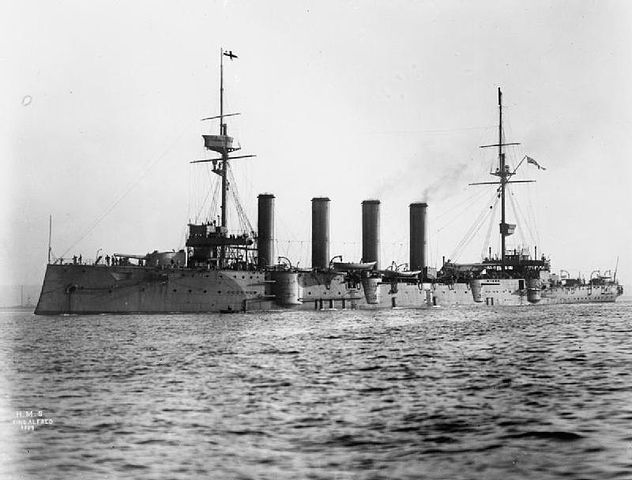
King Alfred in 1901
Most of the ship superstructure amidship was omitted. Cowl ventilators were replaced by windsails while other fittings above the upper deck were reduced to the bare minimum.
In addition two more 12-pounder 8 cwt guns could be dismounted for service ashore. The lead ship, the Drake was the costier of them all, at £1,050,625.
Carrer
Their operational life began as cruiser’s squadron leaders to justify their large size and cost. The King Alfred was the CinC in China until 1910, the Leviathan preceded her in 1903-1904, and was also CinC in the Mediterranean in 1905-1906, but the Good Hope and Drake spent their remaining carrer in Home Waters, until the first was sent as flagship of the South Atlantic squadron, under orders of Commander Kradock. Famously the latter sailed to battle with the Monmouth and Glasgow, facing two formidable German armoured cruisers that punched above her weight, and sank with all hands.
Sources/Links
Drake class cruisers (wiki)
http://dreadnoughtproject.org/tfs/index.php/Drake_Class_Cruiser_(1901)
http://www.historyofwar.org/articles/weapons_drake_class_cruisers.html
http://www.battleships-cruisers.co.uk/drake_class.htm
http://www.navypedia.org/ships/uk/brit_cr_drake.htm
Drake class specifications |
|
| Dimensions | 162.6 x21.7 x7.9m (533 x 71 x 26 ft) |
| Displacement | 14,150 t FL |
| Crew | 900 |
| Propulsion | 2 props, four 4-cyl TE, 43 boilers 30,000 hp |
| Speed | 23 knots (43 kph, 26 mph) |
| Armament | 2x 234mm, 16x152mm, 12x12pdr, 3x3pdr, 2 TT 450mm |
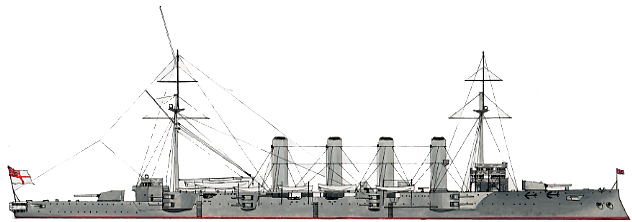
Illustration of the Good Hope by naval encyclopedia

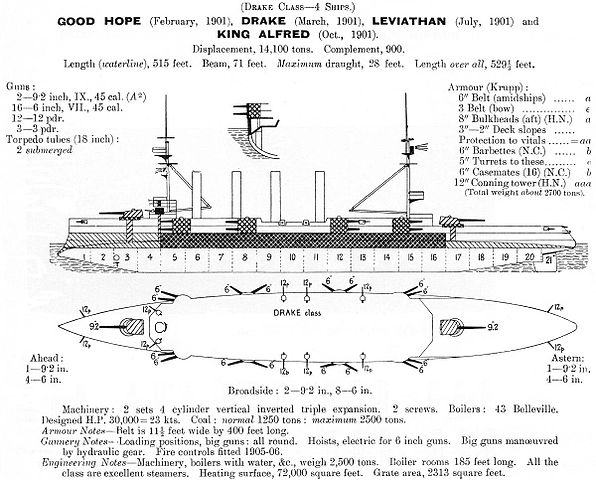
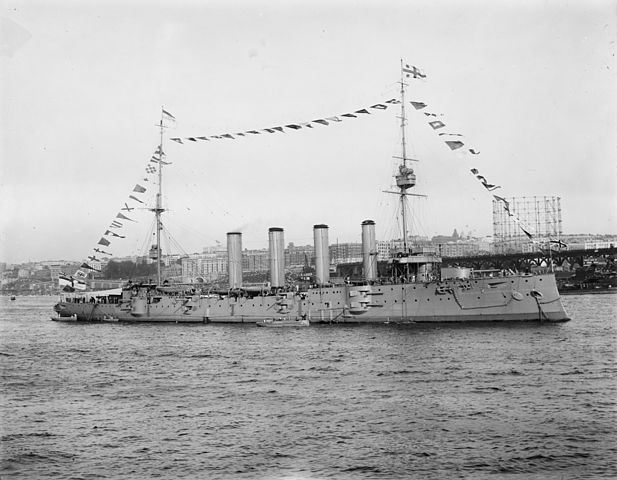
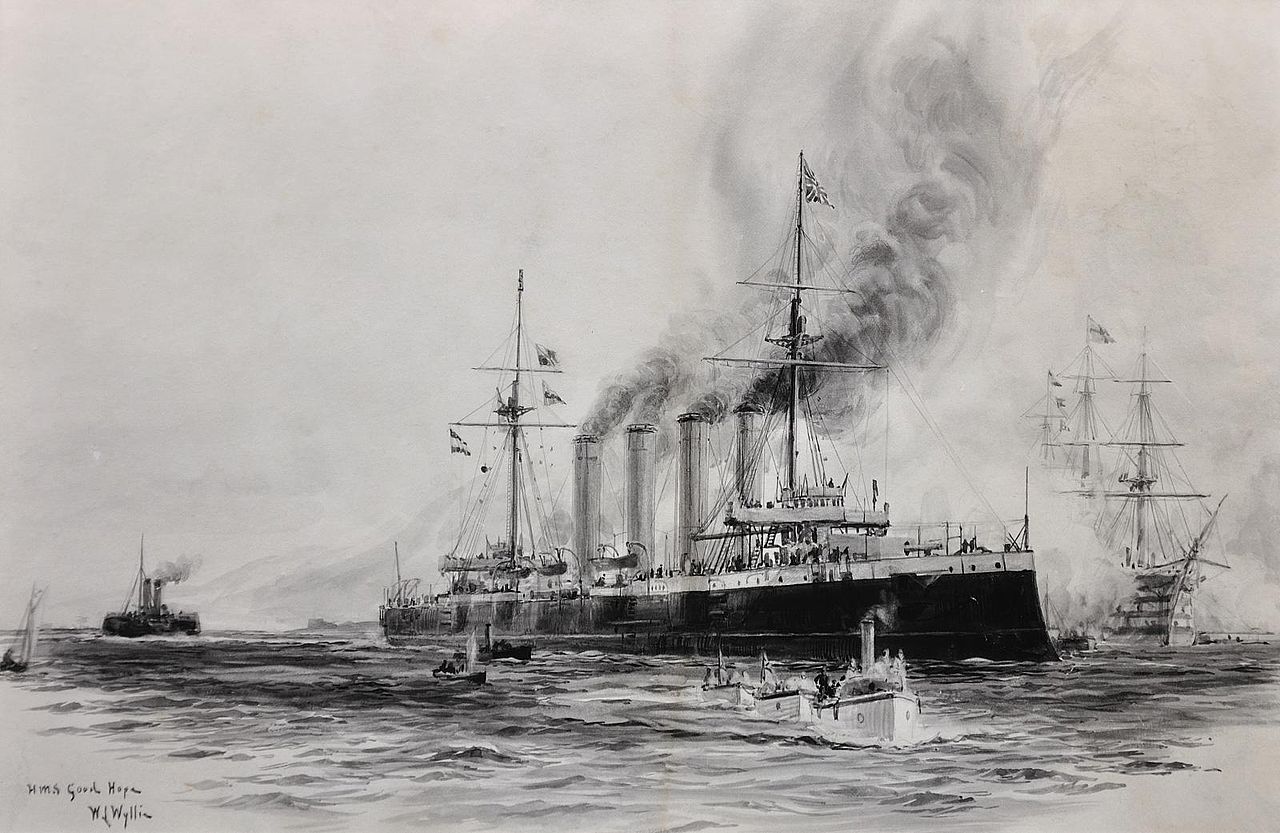
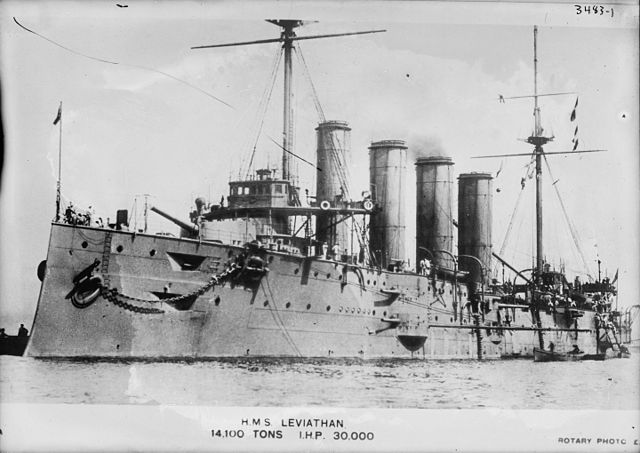
 Latest Facebook Entry -
Latest Facebook Entry -  X(Tweeter) Naval Encyclopedia's deck archive
X(Tweeter) Naval Encyclopedia's deck archive Instagram (@navalencyc)
Instagram (@navalencyc)





 French Navy
French Navy Royal Navy
Royal Navy Russian Navy
Russian Navy Armada Espanola
Armada Espanola Austrian Navy
Austrian Navy K.u.K. Kriegsmarine
K.u.K. Kriegsmarine Dansk Marine
Dansk Marine Nautiko Hellenon
Nautiko Hellenon Koninklije Marine 1870
Koninklije Marine 1870 Marinha do Brasil
Marinha do Brasil Osmanlı Donanması
Osmanlı Donanması Marina Do Peru
Marina Do Peru Marinha do Portugal
Marinha do Portugal Regia Marina 1870
Regia Marina 1870 Nihhon Kaigun 1870
Nihhon Kaigun 1870 Preußische Marine 1870
Preußische Marine 1870 Russkiy Flot 1870
Russkiy Flot 1870 Svenska marinen
Svenska marinen Søværnet
Søværnet Union Navy
Union Navy Confederate Navy
Confederate Navy Armada de Argentina
Armada de Argentina Imperial Chinese Navy
Imperial Chinese Navy Marinha do Portugal
Marinha do Portugal Mexico
Mexico Kaiserliche Marine
Kaiserliche Marine 1898 US Navy
1898 US Navy Sovietskiy Flot
Sovietskiy Flot Royal Canadian Navy
Royal Canadian Navy Royal Australian Navy
Royal Australian Navy RNZN Fleet
RNZN Fleet Chinese Navy 1937
Chinese Navy 1937 Kriegsmarine
Kriegsmarine Chilean Navy
Chilean Navy Danish Navy
Danish Navy Finnish Navy
Finnish Navy Hellenic Navy
Hellenic Navy Polish Navy
Polish Navy Romanian Navy
Romanian Navy Turkish Navy
Turkish Navy Royal Yugoslav Navy
Royal Yugoslav Navy Royal Thai Navy
Royal Thai Navy Minor Navies
Minor Navies Albania
Albania Austria
Austria Belgium
Belgium Columbia
Columbia Costa Rica
Costa Rica Cuba
Cuba Czechoslovakia
Czechoslovakia Dominican Republic
Dominican Republic Haiti
Haiti Hungary
Hungary Honduras
Honduras Estonia
Estonia Iceland
Iceland Eire
Eire Equador
Equador Iran
Iran Iraq
Iraq Latvia
Latvia Liberia
Liberia Lithuania
Lithuania Mandchukuo
Mandchukuo Morocco
Morocco Nicaragua
Nicaragua Persia
Persia San Salvador
San Salvador Sarawak
Sarawak Uruguay
Uruguay Venezuela
Venezuela Zanzibar
Zanzibar Warsaw Pact Navies
Warsaw Pact Navies Bulgaria
Bulgaria Hungary
Hungary

 Bundesmarine
Bundesmarine Dutch Navy
Dutch Navy Hellenic Navy
Hellenic Navy Marina Militare
Marina Militare Yugoslav Navy
Yugoslav Navy Chinese Navy
Chinese Navy Indian Navy
Indian Navy Indonesian Navy
Indonesian Navy JMSDF
JMSDF North Korean Navy
North Korean Navy Pakistani Navy
Pakistani Navy Philippines Navy
Philippines Navy ROKN
ROKN Rep. of Singapore Navy
Rep. of Singapore Navy Taiwanese Navy
Taiwanese Navy IDF Navy
IDF Navy Saudi Navy
Saudi Navy Royal New Zealand Navy
Royal New Zealand Navy Egyptian Navy
Egyptian Navy South African Navy
South African Navy






























 Ukrainian Navy
Ukrainian Navy dbodesign
dbodesign